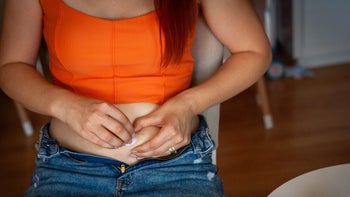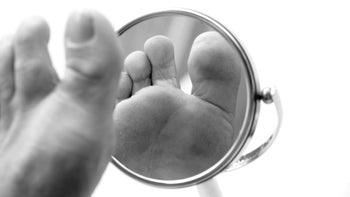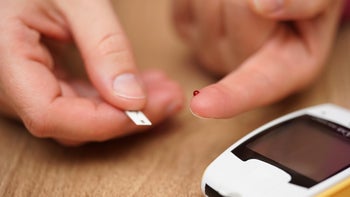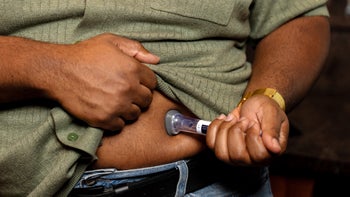
Type 1 vs. Type 2 Diabetes: Your Guide to Understanding Their Differences
Key takeaways:
Diabetes is a condition that causes high blood glucose (sugar). This can happen when the body isn’t making enough insulin, or it isn’t using insulin effectively.
Type 1 and Type 2 diabetes are the most common types of diabetes. Both can cause increased hunger, thirst, urination, fatigue, and blurry vision.
Treatment varies depending on the type of diabetes you have. In addition to lifestyle changes, there are prescription medications that you inhale, inject, or take by mouth. These medications work in different ways to help to lower blood glucose.
Table of contents
Diabetes is a common and serious medical problem. An estimated 34 million people in the U.S. had diabetes in 2018. That’s 1 in 10 people. Diabetes is also a global problem. As of 2021, it affects 537 million adults, or 10% of the world’s population.
There are two main types of diabetes: Type 1 diabetes (T1D) and Type 2 diabetes (T2D). Both cause levels of sugar (glucose) in the blood to be higher than is safe.
But T1D and T2D are different diseases. T2D is the most common type. It affects about 90% to 95% of all people with diabetes. Many people with T2D have a family history of diabetes. But, even with a family risk for diabetes, you can lower your own risk of diabetes with healthy lifestyle changes.
Save on popular GLP-1 Agonists
Take control of your health. With GoodRx, you may be eligible to save even more on popular treatments.

T1D, on the other hand, is an autoimmune type of diabetes that affects about 5% to 10% of people with diabetes. While T1D can develop at any age, it’s more commonly diagnosed in children and young adults.
For most people, figuring out the type of diabetes they have is a straightforward process. But that’s not always the case. That’s because there are different causes and types of diabetes. We’ll focus on the most researched and common forms of diabetes: Type 1 and Type 2.
What is diabetes?
Diabetes is a lifelong health condition that affects how your body turns the food you eat into energy.
In people who do not have diabetes, the pancreas makes insulin. Insulin is a hormone that helps move the glucose (sugar) your body gets from food into the body’s cells for energy. It also helps your body store glucose in your liver, muscles, and fat.
In people who have diabetes, the pancreas does not make enough insulin, or the body does not respond to insulin as it should. This leads to high levels of glucose in the bloodstream — and not enough in storage for when it’s needed. That’s why high blood glucose (hyperglycemia) is the main sign of diabetes.
The main differences between Type 1 vs. Type 2 diabetes
T1D and T2D sound alike, but there are key differences between them. Let’s take a look.
Type 1 diabetes
Type 1 diabetes is an autoimmune disease that happens when the body gets confused and destroys its own insulin-producing cells. As a result, the pancreas does not make enough insulin. And without insulin, you can get really sick, really fast.
Because people with T1D stop making insulin completely, they will need to inject insulin for the rest of their lives.
Type 2 diabetes
In Type 2 diabetes, the pancreas still makes insulin, but the body does not respond to it as it once did. This is one of the main differences between T1D and T2D.
You may have heard of “insulin resistance,” which is when the body starts to ignore the insulin the pancreas makes. The end result is the same as with T1D: Glucose builds up in the bloodstream, causing high blood sugar.
In the early stages of T2D, the pancreas usually makes more insulin to try to overcome insulin resistance. But, over time, the pancreas gets worn out and struggles to make enough insulin. That's why some people with T2D will eventually need to take insulin.
Diabetes symptoms
You might not notice any symptoms in the early stages of diabetes. But as diabetes gets worse, high blood glucose levels will start to cause:
Frequent urination: This is caused by excess sugar in the blood that pulls more water into the blood, kidneys, and urine.
Increased hunger: This is because the body can’t get enough energy (glucose) from the blood into the cells.
Extreme thirst: This is a result of frequent urination and dehydration.
Fatigue and weight loss: The body is in crisis and struggles to get energy.
Blurry vision: High levels of blood sugar levels cause swelling in the cells of the eyes.
Increased risk of infections: Over time, high levels of blood glucose stress the protective immune system and increase the risk of infections.
Sometimes symptoms come on slowly over time. Other times, they can make you extremely ill very suddenly — especially if you don’t know you have diabetes.
Even after diagnosis, it’s normal for blood glucose to go up and down. Medications, physical activity, and diet choices can all affect glucose levels. That’s why it’s important to check your glucose regularly with a glucose meter (glucometer) or wear a continuous glucose monitor.
Life-threatening complications
People with T1D and T2D can have both extremely low and high blood sugars. Both can be life-threatening. Keeping your blood sugar in your target range can help to prevent emergencies and other diabetes-related health complications.
Type 1 diabetes
In T1D, high blood glucose can lead to diabetic ketoacidosis (DKA). These symptoms are similar to the flu and can be confusing for the person experiencing them. DKA is an acute illness that needs emergency medical care.
Type 2 diabetes
In T2D, high blood sugars, certain medications, and infections can cause hyperosmolar hyperglycemic state (HHS). This is a medical emergency.
Diabetes causes
Experts don’t know the exact cause of Type 1 or Type 2 diabetes. They continue to research why some people get it and others don’t.
Type 1 diabetes
T1D is an autoimmune disease in which the body’s immune system mistakenly attacks its healthy pancreas cells. Like with other autoimmune diseases, T1D likely results from a combination of your genetics and environment. Researchers continue to investigate these possible genes and environmental triggers and how they work together to cause T1D.
If you have a close relative with T1D, your risk of developing it is higher. That said, 9 in 10 people diagnosed with T1D have no family history of it. So, it’s not just a question of genetics.
Type 2 diabetes
T2D is a metabolic disease with genetic and environmental causes. You’re at higher risk of developing T2D if a family member has it. But other environmental factors, such as physical activity and body weight, play a role, too.
Other rare causes of diabetes
Although more than 95% of people with diabetes have T1D or T2D, other rare causes of diabetes include:
Gestational diabetes: can develop during pregnancy
Drug-induced diabetes: some medications (such as steroids, diuretics, and antipsychotics) increase blood glucose levels
Monogenic diabetes: a rare form of diabetes caused by a mutation (change) in a single gene
Cystic fibrosis-related diabetes: can occur in people living with cystic fibrosis
Diabetes risk factors
While scientists continue to study the exact cause for T1D and T2D, it’s clear that certain things can increase a person’s risk of developing it. Neither T1D or T2D have a single cause. Rather, it’s likely a combination of genetic and environmental factors that affect a person’s risk.
Type 1 diabetes
Here are some things that can increase your risk of having T1D:
Certain viral infections
Environmental factors
A family history of T1D
Ethnicity
Type 2 diabetes
Here are some risk factors that increase your odds of developing T2D:
Older age, specifically 45 years and older
Heavier weight (BMI of 25 or higher)
Minimal exercise (fewer than three times a week)
A diagnosis of prediabetes
A parent or sibling with T2D
African American, Hispanic/Latino, American Indian, Asian American, or Pacific Islander ethnicity
Additional risk factors for T2D that only apply to women are:
A diagnosis of polycystic ovary syndrome (PCOS)
Giving birth to a baby over 9 pounds
Diabetes diagnosis
There are several different blood tests for diabetes. These tests can diagnose diabetes and monitor how it’s responding to treatment. The same blood tests are used for T1D and T2D.
The tests will not tell you which type of diabetes you have. Only your provider can do that, and the diagnosis is based on your:
Symptoms
Lab test results
Risk factors
Medical history
Family history
Fasting blood glucose test
Fasting blood glucose is the glucose level in your blood when you haven’t had anything to eat or drink except water for 8 to 12 hours (usually overnight). In some situations, this test will need to be repeated to confirm whether you have diabetes.
Normal | Below 100 mg/dL |
Diabetes | 126 mg/dL and above |
Oral glucose tolerance test
This glucose test is also done after you haven’t had anything to eat or drink for 8 to 12 hours (except water). Then you drink a standard-strength, sweetened drink, then you get your blood glucose checked 2 hours later.
Normal | Below 140 mg/dL |
Diabetes | 200 mg/dL and above |
Certain medications, like beta blockers, diuretics, and antidepressants, can interfere with both the fasting blood glucose and the oral glucose tolerance test.
Hemoglobin A1C test
A hemoglobin A1C (HbA1c or A1C) test measures how high your blood glucose has been for the past 2 to 3 months. You don’t need to do any special preparation for this test, so you can even eat right before it.
Normal | Below 5.7% |
Prediabetes | 5.7% to 6.4% |
Diabetes | 6.5% and above |
Most people only need to have one of these three tests done to find out if they have diabetes. Others may need further testing for their provider to be sure. More specific lab tests, such as autoantibody testing, can help to figure out if someone has T1D versus T2D.
Diabetes treatment
Treatments for T1D and T2D have some similarities and differences. Regardless of the type of diabetes you have, here’s how treatment starts:
Choose nutritious foods. Eat a variety of vegetables and fruits, whole grains, fat-free or low-fat dairy foods, and lean proteins. Watch your portion sizes, and try to avoid “empty” calories from sugary foods and drinks.
Stay active. Move your body throughout the day, and get regular exercise. Activity helps to lower blood glucose. Aim for 150 minutes of exercise per week, or 30 minutes a day for 5 days a week.
Maintain a healthy weight. Maintain a weight that’s considered “normal” for your height and sex. If you have been told that you’re overweight, then weight loss can improve your glucose levels and lower your need for medication.
Take medications as prescribed. Get maximum health benefits by taking all of your medications as prescribed.
Monitor your glucose levels. Glucose testing provides useful information about how well your diabetes treatment plan is working. Your care team will set a glucose target range that fits your needs. Aim to stay within this range as much as possible. Testing will vary person-to-person — from quarterly A1C checks to daily glucose testing and CGM use.
While everyone with T1D must inject insulin, or use an insulin pump, only about 1 in 10 people with T2D take insulin. Let’s take a closer look at insulin and other types of medications for diabetes.
Insulin
If you need insulin, you have options for how you use it:
Insulin injections: People with diabetes may use a syringe or an insulin pen to inject insulin. Different types of insulin last for different lengths of time and are coordinated with food choices, blood glucose readings, and physical activities.
Insulin pumps: These are smart, wearable devices that deliver a steady dose of rapid-acting (basal) insulin throughout the day. A tiny plastic tube (catheter) is inserted under the skin and changed every few days. Only fast-acting insulin is delivered in an insulin pump. Bolus (single-dose) insulin is given in addition to basal insulin to match the carbohydrates you eat or to correct out-of-range blood sugars.
Automated insulin delivery (AID) systems: These are the newest devices that adjust and deliver insulin in response to CGM results. AID systems help to take some of the guesswork out of managing diabetes while easing some of the mental burden.
Inhaled insulin: Another way to get insulin is to inhale it into your lungs using a special delivery device. When using an inhalation device, insulin starts acting rapidly within about 12 minutes. But it’s not for everyone. Your insurance needs to approve inhaled insulin. And, if you have T1D (and even sometimes with T2D), you still have to take a long-acting insulin daily. Finally, it’s not recommended for someone with lung problems like asthma, chronic bronchitis, or emphysema.
Other medications for Type 2 diabetes
In addition to making lifestyle changes, many people with T2D also take medications to lower their blood glucose. Besides insulin, the most common types of medications used for people with T2D are:
Metformin (pill)
Sulfonylureas (pill)
GLP-1 agonists (injections)
DPP-4 inhibitors (pill)
SGLT2 inhibitors (pill)
Metformin is recommended as the first-choice treatment for most people with T2D. Other medications can be added on top of metformin, if needed.
You can read more about treatments for diabetes in our guides here:
Diabetes prevention
Although there’s no way to prevent T1D, recent research has successfully delayed its onset. On the other hand, healthy lifestyle changes can prevent or delay T2D.
Type 1 diabetes
Early screening research studies with TrialNet have led to FDA approval of Tzield (teplizumab). This is the first drug that has been used to delay the onset of T1D by 2 or more years.
Because there’s no cure for T1D, screening and treatment are vital in delaying and preventing DKA, which can be life-threatening. TrialNet has other studies underway to slow or stop T1D in those at risk of developing it.
If you have a close relative with T1D, find out if you qualify for screening. You can ask your provider to order lab testing, visit TrialNet, or do an at-home test.
Type 2 diabetes
While you can’t change certain factors, such as your genetics, you can adapt your lifestyle to prevent or delay T2D. Here’s the thing, most people have prediabetes before they develop T2D, but more than 8 in 10 people don’t know they have it.
Prediabetes is a reversible condition when it’s caught in time (before your glucose goes into the T2D range). Prediabetes is very common in the U.S. About 96 million adults, or 1 in every 3 people, have it.
You can check your risk for prediabetes by taking this 1-minute test from the CDC. If you’re at high-risk for prediabetes, talk with your healthcare provider. They can order a blood test to confirm your risk.
The bottom line
Type 1 diabetes (T1D) and Type 2 diabetes (T2D) sound alike, but they’re different diseases. T1D is an autoimmune disease where the body gets confused and destroys its insulin-producing cells. But T2D is a metabolic disease, and it’s much more common than T1D.
Blood glucose (sugar) is high in both conditions — and this is what causes the symptoms and the medical complications of diabetes. Lifestyle changes for people with T1D and T2D are similar too. But the medication you take (if any) is pretty different whether you have T1D or T2D.
Why trust our experts?


References
Adeyinka, A., et al. (2023). Hyperosmolar hyperglycemic syndrome. StatPearls.
American Diabetes Association. (n.d.). Blood glucose and A1C diagnosis.
American Diabetes Association. (n.d). Insulin basics.
American Diabetes Association. (2018). Classification and diagnosis of diabetes: Standards of Medical Care in Diabetes—2019. Diabetes Care.
American Diabetes Association. (2018). Pharmacologic approaches to glycemic treatment: Standards of Medical Care in Diabetes—2019. Diabetes Care.
Centers for Disease Control and Prevention. (2020). National Diabetes Statistics Report 2020: Estimates of diabetes and its burden in the United States.
Centers for Disease Control and Prevention. (2022). National Diabetes Statistics Report.
Centers for Disease Control and Prevention. (2022). Prediabetes - Your chance to prevent Type 2 diabetes.
Centers for Disease Control and Prevention. (2022). Prediabetes risk test.
Centers for Disease Control and Prevention. (2022). Prevalence of diagnosed diabetes.
Centers for Disease Control and Prevention. (2022). Prevent Type 2 diabetes.
Centers for Disease Control and Prevention. (2023). Type 2 diabetes.
Centers for Disease Control and Prevention. (2023). What is Type 1 diabetes?
Enable Biosciences. (n.d.). Type 1 testing.
Fillipi, C. M., et al. (2008). Viral trigger for Type 1 diabetes. Diabetes.
IDF Diabetes Atlas. (n.d.). Diabetes in the world in 2021. International Diabetes Federation.
Juvenile Diabetes Research Foundation. (n.d.). Causes of Type 1 diabetes.
Mannkind Corporation. (2023). Afrezza - insulin human powder, metered, and human kit [package insert]. DailyMed.
Mobasseri, M., et al. (2020). Prevalence and incidence of type 1 diabetes in the world: A systematic review and meta-analysis. Health Promotion Perspectives.
National Institute of Diabetes and Digestive and Kidney Diseases. (2022). Risk factors for Type 2 diabetes.
Rewers, M., et al. (2017). Environmental risk factors for type 1 diabetes. The Lancet.
Steck, A. K., et al. (2011). Genetics of Type 1 diabetes. Clinical Chemistry.
Type 1 Diabetes TrialNet. (n.d.). Participate.
Type 1 Diabetes TrialNet. (n.d.). Pathway to prevention.
Type 1 Diabetes TrialNet. (n.d.). TrialNet research leads to FDA approval of first drug to delay Type 1 diabetes.

























